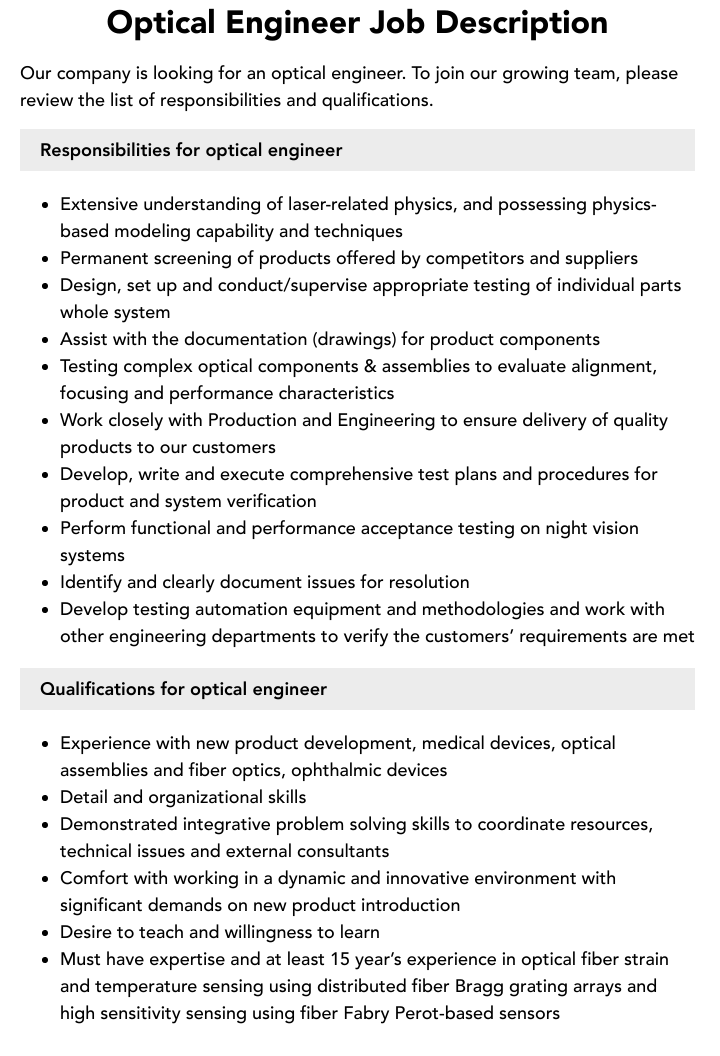Imagine gazing through a telescope at the distant cosmos, pondering not only what lies beyond our world but also the marvel of optical engineering that allows us to perceive such grandeur. What if you could harness the principles of light to forge a career that bridges the realms of science and technology? The ever-evolving field of optical engineering opens a treasure trove of opportunities, albeit with its own unique set of challenges. In this exploration, we delve into the multifaceted career prospects for optical engineers, illuminating the paths available to those in this field.
Optical engineering, a discipline at the confluence of physics, material science, and engineering, focuses on the manipulation of light and its applications across diverse industries. From designing intricate optical systems to developing advanced imaging technologies, the opportunities are extensive. The pressing question arises: What specific job trajectories exist within this captivating realm?
1. Aerospace and Defense
In the aerospace and defense sectors, optical engineers play a pivotal role in designing and refining high-performance optical systems. These systems include various applications such as imaging sensors, laser systems, and reconnaissance instruments. The challenge lies in creating devices that operate efficiently in extreme conditions, demanding a rigorous understanding of atmospheric optics and interference phenomena. Hence, professionals in this sector contribute significantly to advancements in surveillance and navigation systems, ensuring both security and exploration endeavors.
2. Telecommunications
With the exponential growth of data transmission, optical engineers are integral to the telecommunications industry. They are tasked with engineering fiber optic communication systems that deliver high-speed internet and telecommunication services. Cutting-edge research in this field delves into optical signal processing and photonic integration, necessitating a detailed comprehension of waveguide theories and modulation techniques. The quest to enhance bandwidth and reduce signal degradation is a continuous challenge, thus fostering a stimulating environment for innovation.
3. Medical Devices
The healthcare sector presents another promising avenue for optical engineers, particularly in the development of medical imaging systems such as optical coherence tomography (OCT) and fluorescence imaging. These technologies allow for non-invasive diagnostics, revolutionizing how we visualize biological systems. The challenge lies in enhancing resolution and depth of penetration without compromising patient safety. Therefore, optical engineers must traverse the intersection of optical physics and biomedical engineering, crafting devices that yield high fidelity while being accessible to medical practitioners.
4. Consumer Electronics
Consumer electronics is perhaps one of the most visible arenas for optical engineers. They are crucial in the design and enhancement of imaging systems in smartphones, cameras, and displays. As the demand for quality imaging rises, engineers face the challenge of balancing miniaturization with performance. This involves not only optimizing lens designs but also considering aspects like aberration correction and color fidelity. The rapid pace of technological advancement in this sector posits a dynamic work environment filled with continual learning opportunities.
5. Academia and Research
For those inclined towards research and pedagogy, academia offers a fruitful career path. Optical engineers in this realm engage in both teaching and conducting innovative research, often exploring fundamental questions about light behavior and developing new technologies. The challenge here is to secure funding for groundbreaking projects while contributing to the body of knowledge that shapes future generations of engineers. Publications in peer-reviewed journals and participation in conferences are essential for establishing oneself in the academic community.
6. Laser Technologies
Another cornerstone of optical engineering is the advancement of laser technologies, where engineers focus on developing new laser systems for industrial, medical, and military applications. Whether it’s improving laser cutting systems in manufacturing or refining laser therapies in medicine, the challenges are both technical and regulatory. Mastery of laser principles, material interactions, and safety standards is imperative in this field, making it a complex but rewarding career path.
7. Environmental Sensing
Optical engineers are also at the forefront of environmental monitoring and sensing technologies. They develop optical sensors that detect pollutants, analyze atmospheric conditions, and monitor climate change variables. The challenge is to create systems that are both sensitive and robust, capable of functioning in diverse environmental conditions. Such endeavors are crucial for advancing our understanding of ecological changes and supporting sustainable practices.
8. Entertainment and Virtual Reality
The burgeoning fields of virtual reality (VR) and augmented reality (AR) have sparked new interest in optical engineering. Engineers are tasked with creating immersive optical displays that enhance user experience in gaming and training environments. The technological challenge lies in achieving realistic imagery while minimizing latency—requiring innovative approaches to optics and display technology. This intersection of entertainment and engineering is particularly appealing to those who thrive on creativity and innovation.
In conclusion, the career landscape for optical engineers is diverse and abundant with potential. From aerospace ventures to the cutting-edge realms of consumer electronics and entertainment, these professionals navigate a myriad of challenges and opportunities. As the world continues to evolve technologically, so too will the role of optical engineers, underscoring the importance of their expertise in shaping our future. The question is, are you ready to embark on this illuminating journey? The challenges are considerable, yet the rewards promise to be equally profound.












